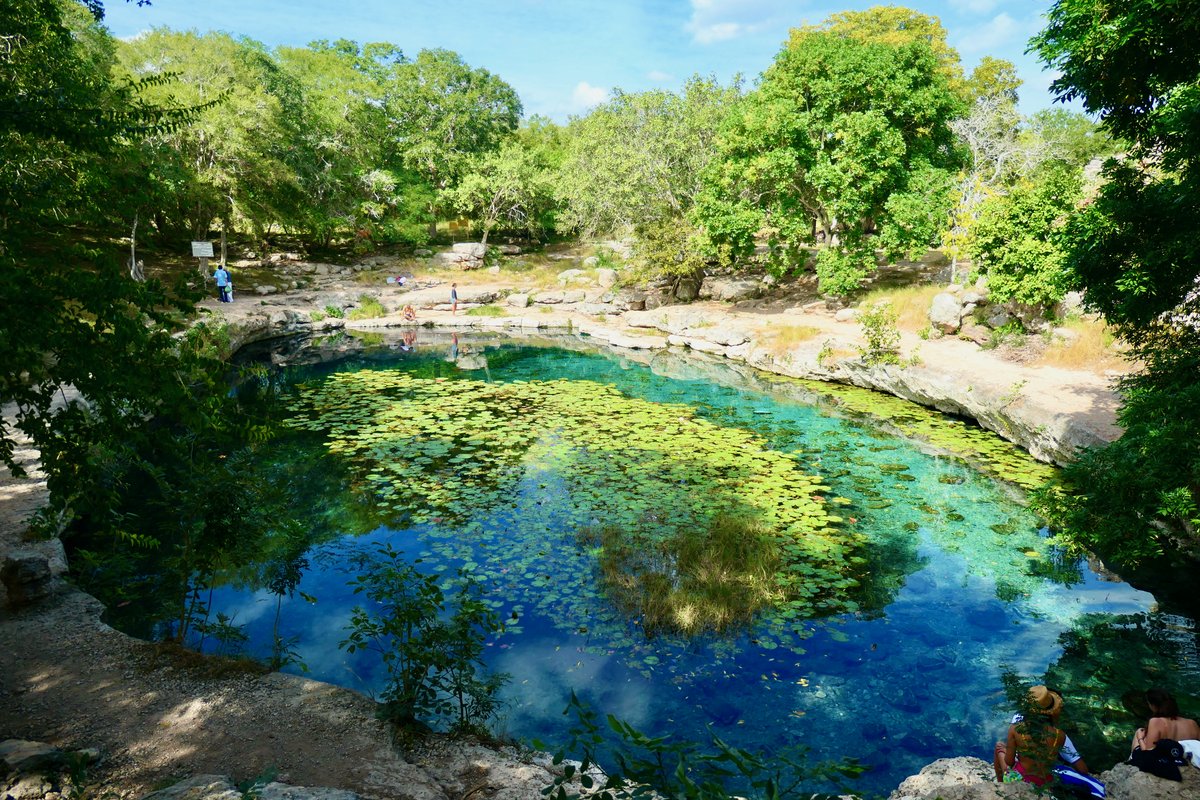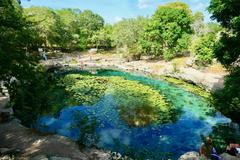
Comprehensive Guide to Visiting Zona Arqueológica de Dzibilchaltún, Mérida, Mexico
Date: 18/07/2024
Introduction
Discover the rich history and cultural significance of the Zona Arqueológica de Dzibilchaltún, one of the most ancient and important archaeological sites near Mérida, Mexico. Located just 16 kilometers from the city, Dzibilchaltún offers visitors a unique glimpse into the past of the Maya civilization. The name Dzibilchaltún translates to ‘place where there is writing on flat stones,’ reflecting the numerous stelae found at the site. First settled around 500 BCE, Dzibilchaltún reached its peak during the Late Classic period (600-900 CE) with an estimated population of 20,000 inhabitants. This guide provides everything you need to know, from the site’s historical background and significance to practical visitor information, including Dzibilchaltún visiting hours, ticket prices, and travel tips. Whether you’re a history enthusiast, a casual traveler, or someone looking to explore the wonders of the Maya civilization, Dzibilchaltún is a must-visit destination.
Table of Contents
- Introduction
- History and Significance
- Cultural and Economic Significance
- Archaeological Discoveries and Research
- Visitor Information
- Nearby Attractions
- Modern-Day Significance
- FAQ
- Conclusion
History and Significance
Early Settlement and Development
The Zona Arqueológica de Dzibilchaltún, located near Mérida, Mexico, is one of the oldest and most significant archaeological sites in the Yucatán Peninsula. Archaeological evidence suggests that Dzibilchaltún was first settled around 500 BCE, making it one of the earliest known Maya settlements. The city reached its peak during the Late Classic period (600-900 CE), with an estimated population of 20,000 inhabitants.
Architectural Highlights
The Temple of the Seven Dolls
One of the most iconic structures at Dzibilchaltún is the Temple of the Seven Dolls, named after seven small effigies found during its excavation. This temple is particularly famous for its astronomical alignment. During the equinoxes, the sun rises directly through the temple’s doorways, creating a spectacular light show that attracts visitors and researchers alike. This alignment underscores the Maya’s advanced understanding of astronomy and their ability to integrate it into their architectural designs (INAH).
The Cenote Xlakah
Another significant feature of Dzibilchaltún is the Cenote Xlakah, a natural sinkhole that provided a crucial water source for the ancient city. The cenote has yielded numerous artifacts, including pottery, tools, and human remains, offering valuable insights into the daily lives and rituals of the Maya people. The cenote’s clear waters continue to be a focal point for both archaeological research and tourism (Yucatán Today).
Cultural and Economic Significance
Trade and Economy
Dzibilchaltún was a major economic hub due to its strategic location between the Gulf of Mexico and the interior of the Yucatán Peninsula. The city was part of an extensive trade network that connected it with other Maya cities and distant regions. Artifacts such as obsidian, jade, and ceramics found at the site indicate that Dzibilchaltún engaged in long-distance trade, which contributed to its prosperity and growth (Smithsonian Magazine).
Religious and Ceremonial Importance
The city’s layout and architecture reflect its religious and ceremonial significance. The central plaza, surrounded by temples and administrative buildings, served as the heart of the city’s religious activities. The Temple of the Seven Dolls, with its astronomical alignments, likely played a crucial role in the city’s ceremonial calendar. Additionally, the numerous stelae and altars found throughout the site suggest that Dzibilchaltún was a center for religious rituals and offerings (National Geographic).
Archaeological Discoveries and Research
Excavations and Findings
Systematic archaeological excavations at Dzibilchaltún began in the mid-20th century, led by the National Institute of Anthropology and History (INAH). These excavations have uncovered a wealth of information about the city’s history, architecture, and daily life. Notable discoveries include the Temple of the Seven Dolls, residential complexes, and the cenote’s artifacts. These findings have significantly contributed to our understanding of the Maya civilization and its development over time (INAH).
Preservation and Conservation Efforts
Preservation and conservation efforts at Dzibilchaltún are ongoing, aimed at protecting the site’s architectural and cultural heritage. These efforts include stabilizing structures, preventing erosion, and managing vegetation growth. The site is also part of a broader initiative to promote sustainable tourism, ensuring that visitors can enjoy and learn from Dzibilchaltún without compromising its integrity (UNESCO).
Visitor Information
Tickets and Visiting Hours
Dzibilchaltún is open to visitors from 8:00 AM to 5:00 PM daily. Tickets can be purchased on-site or online, with prices typically ranging from $5 to $10 USD for adults. Discounts are often available for students, seniors, and local residents. It’s advisable to check the official INAH website for the most up-to-date information on ticket prices and visiting hours.
Travel Tips
- Getting There: Dzibilchaltún is located approximately 16 kilometers from Mérida, making it easily accessible by car or public transportation. Taxis and tour buses are also available from Mérida.
- Best Time to Visit: The best time to visit is during the cooler months from November to February. Visiting during the early morning or late afternoon can help you avoid the midday heat.
- What to Bring: Bring comfortable walking shoes, water, sunscreen, and a hat. There are limited facilities on-site, so it’s a good idea to bring snacks or a packed lunch.
Nearby Attractions
While visiting Dzibilchaltún, consider exploring other nearby attractions in Mérida and the Yucatán Peninsula. Some popular sites include:
- Mérida Historical Sites: The historic center of Mérida, with its colonial architecture and vibrant markets.
- Progreso Beach: A beautiful beach town located about 30 kilometers from Dzibilchaltún, perfect for a relaxing day trip.
- Uxmal: Another significant Maya archaeological site, known for its impressive pyramids and well-preserved structures.
Modern-Day Significance
Tourism and Education
Today, Dzibilchaltún is a popular tourist destination, attracting visitors from around the world. The site’s well-preserved structures, combined with its historical and cultural significance, make it a must-visit for anyone interested in the Maya civilization. The on-site museum, Museo del Pueblo Maya, offers additional context and exhibits, including artifacts from the cenote and other parts of the site. Educational programs and guided tours further enhance the visitor experience, providing in-depth insights into the history and significance of Dzibilchaltún (Visit Mexico).
Cultural Heritage and Community Involvement
Dzibilchaltún also holds cultural importance for the local community. The site is a symbol of the region’s rich heritage and serves as a venue for cultural events and ceremonies. Community involvement in the site’s preservation and promotion is crucial, ensuring that Dzibilchaltún remains a vibrant and integral part of the local cultural landscape (Yucatán Today).
FAQ
Q: What are the Dzibilchaltún visiting hours?
A: The site is open daily from 8:00 AM to 5:00 PM.
Q: How much do Dzibilchaltún tickets cost?
A: Ticket prices typically range from $5 to $10 USD for adults. Discounts are available for students, seniors, and local residents.
Q: What should I bring when visiting Dzibilchaltún?
A: Bring comfortable walking shoes, water, sunscreen, a hat, and snacks or a packed lunch.
Q: Are guided tours available?
A: Yes, guided tours are available and recommended for a more in-depth understanding of the site.
Conclusion
The Zona Arqueológica de Dzibilchaltún stands as a testament to the ingenuity and sophistication of the ancient Maya civilization. From the architectural marvel of the Temple of the Seven Dolls to the serene and historically rich Cenote Xlakah, Dzibilchaltún provides valuable insights into the daily lives, religious practices, and advanced astronomical knowledge of the Maya people. Today, it is not only a site of immense historical and cultural significance but also a vibrant part of the local community, attracting tourists and researchers from around the world. Whether you visit to witness the equinox phenomenon, explore the museum, or simply enjoy the natural beauty and tranquility of the site, Dzibilchaltún offers a unique and enriching experience. For those planning a visit, remember to check the latest information on ticket prices and visiting hours on the official INAH website and consider hiring a local guide to enhance your understanding of this remarkable archaeological site.
References
- National Institute of Anthropology and History (INAH). (n.d.). Retrieved from https://www.inah.gob.mx/
- Yucatán Today. (n.d.). Retrieved from https://yucatantoday.com/
- Smithsonian Magazine. (n.d.). Retrieved from https://www.smithsonianmag.com/
- National Geographic. (n.d.). Retrieved from https://www.nationalgeographic.com/
- UNESCO. (n.d.). Retrieved from https://whc.unesco.org/
- Visit Mexico. (n.d.). Retrieved from https://www.visitmexico.com/

